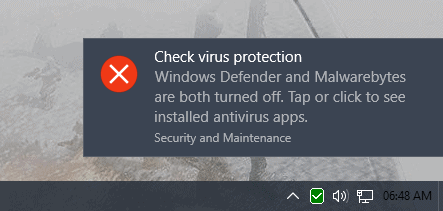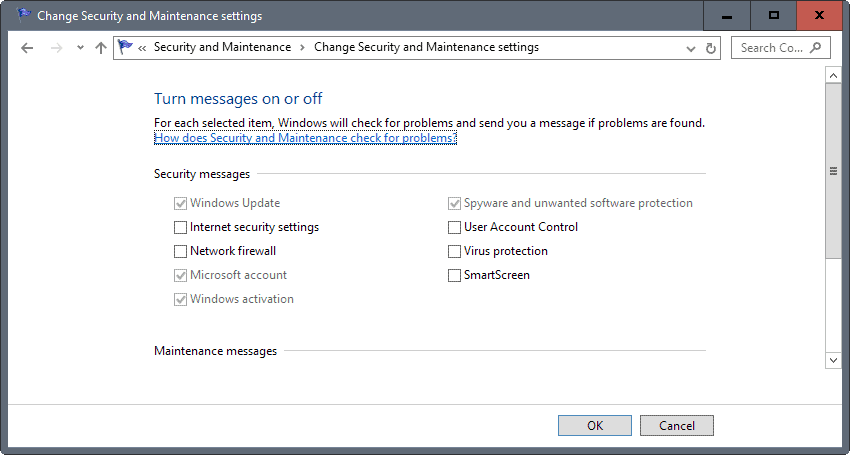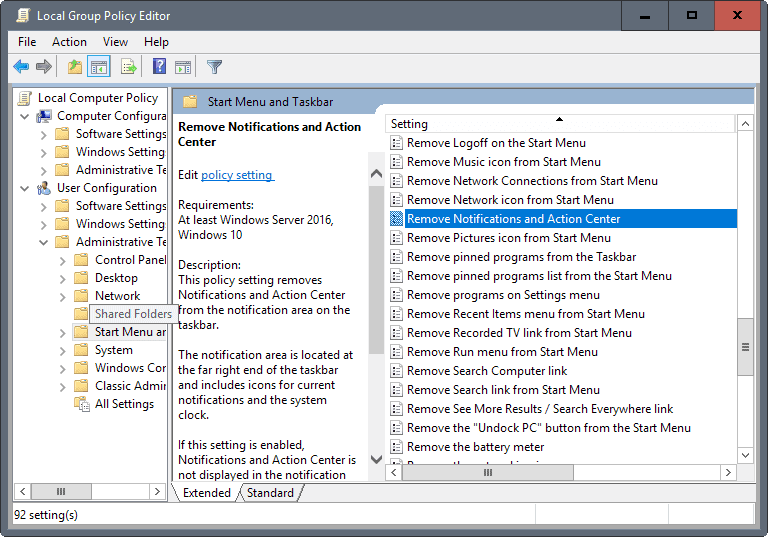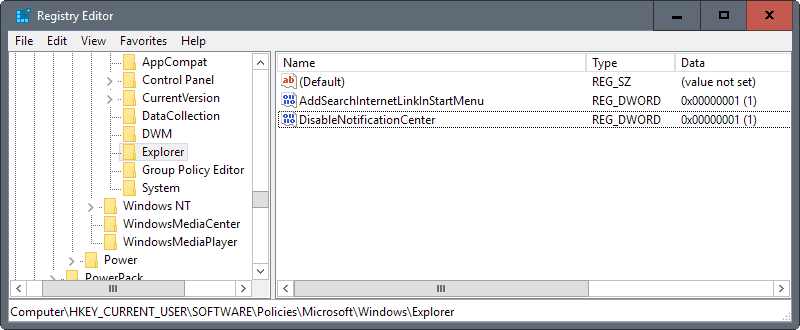Disable Security Messages on Windows 10

The following guide explains how to disable security messages on Windows 10 to prevent popup notifications on the desktop.
Windows 10 monitors security and maintenance related features and settings, antivirus protection and Windows Update for instance, and notifies you if something is not working correctly.
If antivirus protection is turned off for instance, you get a notification to check the virus protection.While that is certainly useful if you are not aware of it, it can become annoying quickly if you know that already, or if Windows failed to read the situation correctly.
This feature is not new, but it has become more difficult to control in Windows 10.
I never cared for the messages that Windows' Security and Maintenance functionality would throw on the desktop; ever since I upgraded to Malwarebytes 3, I noticed an increase in messages stating to check virus protection. This is caused by Malwarebytes 3 failing to enable some of its protection modules at times.
The main issue with these messages is that they take focus. If I type in a browser, and one of those messages pops up, the last ten or so characters that I typed would end up in nirvana due to the lost focus of the browser window. Another issue is that they play a sound on top of that.
Disable Security Messages on Windows 10

First, the things that don't work: You find a lot of tutorials online to turn off the Action Center. But turning off the Action Center won't neccessarily turn off the notifications that Windows throws when it detects an issue on the system.

Additionally, turning messages off under Security and Maintenance > Change Security and Maintenance Settings, does not work either. You may disable virus protection security messages there, but a quick test revealed that Windows would still throw "check virus protection" messages afterwards.
Hiding the Action Center icon in the Settings application won't stop Windows from displaying security and maintenance messages either.
Disabling security messages
Two methods exist to disable security messages on Windows 10. One is a policy, the other the corresponding Registry key.
Method 1: Group Policy

The Group Policy Editor is only available in Windows 10 Pro and Enterprise editions. It is not available in Home editions. If you run a Home edition, skip this option and jump directly to method 2 below.
If you don't know which version of Windows you are running, use the keyboard shortcut Windows-Pause to find out. Windows displays the version, e.g. Windows 10 Pro, at the top of the window that opens.
To add the policy to a Windows machine, do the following:
- Tap on the Windows-key, type gpedit.msc, and hit the Enter-key. This starts the Group Policy Editor on the system.
- Use the sidebar to go to User Configuration > Administrative Templates > Start Menu and Taskbar.
- Locate Remove Notifications and Action Center there. If the list is not sorted alphabetically, click on the "setting" column title to do so. This makes it easier to find the policy.
- Double-click on the policy.
- Set it to enabled.
- Restart the PC
The policy has the following description:
This policy setting removes Notifications and Action Center from the notification area on the taskbar.
The notification area is located at the far right end of the taskbar and includes icons for current notifications and the system clock.
If this setting is enabled, Notifications and Action Center is not displayed in the notification area. The user will be able to read notifications when they appear, but they won’t be able to review any notifications they miss.
If you disable or do not configure this policy setting, Notification and Security and Maintenance will be displayed on the taskbar.
A reboot is required for this policy setting to take effect.
Method 2: Windows Registry

You can make the same change directly using the Windows Registry Editor.
- Tap on the Windows-key, type regedit.exe, and hit the Enter-key on the keyboard afterwards.
- Confirm the UAC prompt that appears.
- Go to HKEY_CURRENT_USER\SOFTWARE\Policies\Microsoft\Windows\Explorer using the left sidebar menu. If Explorer does not exist, right-click on Windows and select New > Key, and name it Explorer.
- Right-click on Explorer, and select New > Dword (32-bit) Value.
- Name it DisableNotificationCenter.
- Double-click the new entry afterwards, and set its value to 1.
- Restart the PC.
I have created a Registry file that you can run on your computer to make the change directly, and without having to edit the Registry manually. Click on the following link to download the archive to your computer: (Download Removed)
The file disable-security-notifications.reg disables security notifications on your PC when executed, while enable-security-notifications.reg enables the messages again.
Now You:Â Do you find security notifications useful on Windows?





















I have Windows 10, 19H1 Build 18362, I believe that some people are having trouble because of updates that are installed that affect this or these methods, I edited the registry file using (Run As Admin) method by right clicking on the file or shortcut, sometimes just by opening Registry file normally it does not save the changed do to Microsoft security policies. But edited and created the Explorer folder in the Regisrty, created the Key and Dword with value 1, closed Registry then restarted and the Notification box dissapeared from the Low-Right Taskbar Menu, Thank you Martin and those who created this page for the following information.
Method 1: Group Policy worked well for me, but now I don’t have any notifications at all.
I wanted to disable firewall notifications only but that seems impossible from what I’ve found.
Why are Microsoft such a-holes is beyond me.
This is proof that Microsoft are intentionally screwing with people.
https://answers.microsoft.com/en-us/windows/forum/all/security-check-boxes-are-in-grayed-out-state-in/67631a4c-3ce3-460a-87de-5b7f3688b43e
This sollution is only for 1607, to truly disable messages in 1709 and foward you need to go to admin – windows components – windows security – messages – hide messages.
The above methods do not work at all. you will have to manually disable the virus protection notifications by going to Manage security and maintenance in Control panel and uncheck virus protection.
i could not solve issue
I have tired everything, nothing worked. FYI – To run in CMD: REG ADD HKEY_CURRENT_USER\SOFTWARE\Policies\Microsoft\Windows\Explorer /v DisableNotificationCenter /t REG_DWORD /d 1
Method 1 Worked fine for me, thanks! By the way, you can also check what version of windows your’e using by clicking the windows button and typing winver.
If I do this change under Local Machine instead of Current User, will it disable it for all users?
doesn’t work everytime i start computer i get bs annoying message turn on security center
I did everything you suggested…..did not work!!! Still get the notification pop up!
Windows 10 1709, Firewall is off but still producing popups.
We know Control Panel > Change Security and Maintenance settings > Turn messages on or off > uncheck Network firewall works for a standard-user account, but how can this be done from the command-line for a standard user account (non administrator)?
GPO and registry changes are not options.
Thank you.
After 10 days of hard work “Method 1: Group Policy” definitely helped me!
Thanks
GP solution: “The user will be able to read notifications when they appear”
I thought we were trying to stop messages appearing? Glad I didn’t do this. The registry key didn’t work for me, followed the guide to the letter and rebooted. Got notification that my windows firewall and AV firewall were disabled.
Figure out a way to remove the security messages without disabling the action center, and then we’ll talk.
Thanks again for another great tip. The nagging was quite annoying.
To be clear: these actions disable more than just security messages, which the article should spell out. I definitely appreciate both the Quick Access panel and the notifications that persist in the Action Center, more than enough to deal with the occasional security message, for sure.
I saw “security messages” over and over in the article, and it made me doubt what I was pretty sure it would mean to disable the Action Center, enough that I Googled to check.
Windows 10 doesn’t let me merge your registry file by right-click and “merge”..? Not a registry file it says. It want’s me to import it from within the registry editor, which will basically blow up my laptop, burn down my house and kill my dog I am sure.
Martin, you have both methods as “method 1″. I think you meant method 2 on the 2nd one. :-)
Also, when I ran your reg script, i got the following error: ‘cannot import … The specified file is not a registry script. You can only import binary registry files from within the registry editor”
When I attempted to import it from within regedit, I got the error “Cannot import. the key selected is invalid”
Jeff, thanks for letting me know. I have replaced the files, they work properly now when executed.